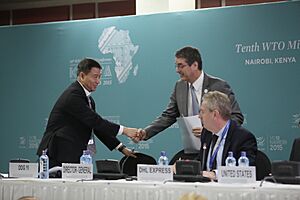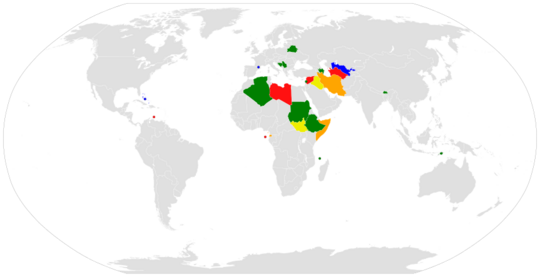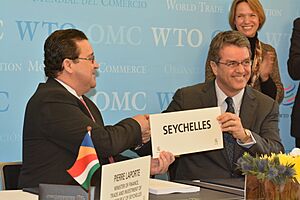World Trade Organization facts for kids
|
Organisation mondiale du commerce
Organización Mundial del Comercio |
|
 |
|

Members Members, dually represented by the European Union (EU) Observers Non-participant states Not applicable
|
|
| Abbreviation | WTO |
|---|---|
| Formation | 1 January 1995 |
| Type | Intergovernmental organization |
| Purpose | Reduction of tariffs and other barriers to trade |
| Headquarters | Centre William Rappard, Geneva, Switzerland |
|
Region served
|
Worldwide |
|
Membership
|
166 members (162 UN member states, the European Union, Hong Kong, Macao, and Taiwan) |
|
Official languages
|
English, French, Spanish |
|
Director-General
|
Ngozi Okonjo-Iweala (since 2021) |
|
Budget
|
CHF 204,928,900 (2024) |
|
Staff
|
approx. 630 (as of December 31, 2024) |
The World Trade Organization (WTO) is an international group that helps countries trade with each other. It makes sure trade is fair and smooth. The WTO started on January 1, 1995. It took over from an older agreement called the General Agreement on Tariffs and Trade (GATT), which began in 1948.
The WTO is the world's biggest international economic organization. It has 166 members, including countries and special customs areas. These members make up over 98% of all global trade. The WTO's main office is in Geneva, Switzerland.
The WTO's main jobs are to create rules for trade agreements. It also helps solve trade disagreements between its members. The agreements cover trade in goods, services, and intellectual property (like inventions or creative works). These rules are agreed upon by most trading nations. They are then approved by each country's parliament.
The WTO works on the idea of treating everyone equally. This means a country should not favor one trading partner over another. However, there are some exceptions, for example, to protect the environment or for national security.
The most important group in the WTO is the Ministerial Conference. It meets every two years. It makes big decisions by agreement from all members. Daily tasks are handled by the General Council. This council has representatives from all member countries. The WTO is run by a leader called the Director-General. Since 2021, Ngozi Okonjo-Iweala from Nigeria has held this role.
Many studies show that the WTO has helped increase trade and lower trade barriers. But some people criticize it. They say that the benefits of free trade are not shared fairly. They also argue that the rules might not help developing countries enough. Some critics also feel that business interests are put before environmental or worker safety concerns.
Contents
- How the WTO Started
- What the WTO Does
- Important Publications
- Main Rules of the Trading System
- NGO and CSO Participation
- How the WTO is Organized
- How Decisions Are Made
- Solving Trade Disagreements
- Joining the WTO
- Key Agreements
- The Director-General's Office
- Budget and Funding
- Impact of the WTO
- See also
How the WTO Started
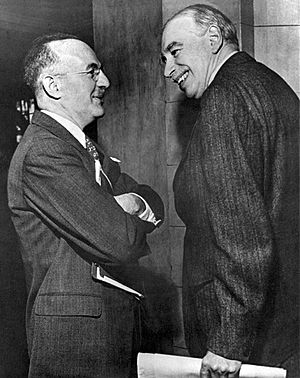
The WTO's earlier version was called the General Agreement on Tariffs and Trade (GATT). It was set up in 1947 by 23 countries. This happened after World War II. Other groups like the World Bank and the International Monetary Fund were also created around that time. They all aimed to help countries work together on economic issues.
There was a plan for a bigger trade organization called the International Trade Organization (ITO). But the United States and other countries did not approve it. So, GATT became the main international trade group for many years.
GATT Negotiations and Changes
For almost 50 years, GATT helped countries reduce tariffs (taxes on imported goods). There were several rounds of talks. The "Kennedy Round" in the 1960s added rules against dumping (selling goods too cheaply). The "Tokyo Round" in the 1970s tried to deal with other trade barriers, not just tariffs.
The Uruguay Round: Creating the WTO
By the mid-1980s, the GATT system needed updates. The world economy was becoming more connected. So, in 1986, a new round of talks began in Punta del Este, Uruguay. This was called the "Uruguay Round."
These talks were very ambitious. They aimed to include new areas like trade in services and intellectual property. They also wanted to reform trade in farming and textiles. The talks ended in 1994 in Marrakesh, Morocco. This is where the agreement to officially create the WTO was signed. It is known as the Marrakesh Agreement.
GATT still exists today as part of the WTO's rules for goods. But the WTO also includes many other agreements. These cover services, intellectual property, and how to settle trade disputes.
Ministerial Conferences: Big Meetings
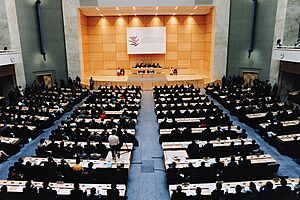
The Ministerial Conference is the WTO's highest decision-making group. It usually meets every two years. All WTO members, including countries and customs unions, attend these meetings. They can make decisions on any of the trade agreements.
Some meetings have seen disagreements, for example, between richer and developing countries over farm subsidies. The 1999 meeting in Seattle even led to large protests. The 2001 conference in Doha, Qatar, was important. It approved China joining the WTO. It also started the "Doha Development Round" of talks.
The Twelfth Ministerial Conference (MC12) took place in Geneva, Switzerland, from June 12-17, 2022. The Thirteenth Ministerial Conference (MC13) was held in Abu Dhabi, United Arab Emirates, from February 26 to March 1, 2024.
Doha Round: Ongoing Talks
The "Doha Development Round" of talks started in 2001. The goal was to make globalization fairer and help poorer countries. This included reducing trade barriers and subsidies in farming.
However, these talks have faced challenges. Richer countries and developing countries have disagreed on issues like industrial tariffs and farm subsidies. These disagreements have made it hard to finish the round. Because of this, many countries have started making their own trade agreements with each other.
What the WTO Does
The WTO helps countries grow by making trade easier. Here are some of its key roles:
- It makes sure that trade agreements are followed.
- It provides a place for countries to talk about trade rules.
- It helps solve trade disagreements between members.
The WTO also checks and shares information about countries' trade policies. This helps make trade rules clear and consistent. It also helps developing countries understand and follow WTO rules. It does this through training and support.
As the world becomes more connected, the WTO's role is very important. It helps manage trade when problems like protectionism or unfair subsidies come up. The WTO acts as a mediator between countries. It helps solve problems that arise from different trade rules.
The WTO also does economic research. It publishes reports on global trade. It works closely with the International Monetary Fund (IMF) and the World Bank. These are two other important international economic groups.
Important Publications
The WTO publishes important reports that explain global trade. These are helpful for anyone interested in trade.
World Trade Report
The World Trade Report is a key publication. It looks at current trade trends and challenges. It gives deep insights into how the global trading system is changing. It also explains its impact on society and economies.
WTO Annual Report
The WTO Annual Report gives a full overview of the organization's activities each year. It includes details on the WTO's budget and staff. This shows its commitment to being open and responsible in managing global trade.
World Trade Statistical Review
The World Trade Statistical Review replaced an older publication. It is the WTO's main source for yearly trade data. It offers detailed analysis and statistics on the latest world trade developments. This makes it a vital resource for global trade information.
Main Rules of the Trading System
The WTO sets up a framework for trade policies. It does not tell countries exactly what to trade. Instead, it sets the rules for "trade policy." Five main rules are very important for understanding the WTO:
- Non-discrimination. This means treating all WTO members equally. If a country offers a special trade deal to one member, it must offer the same deal to all other members. This is called "most-favored-nation" (MFN) treatment. Also, imported goods should be treated the same as goods made in the home country. This is called "national treatment." There are some exceptions, like for free trade agreements or help for developing countries.
- Reciprocity. This means that if one country lowers its trade barriers, other countries should do the same. This helps ensure that all countries benefit from trade agreements.
- Binding and enforceable commitments. When WTO members agree to lower tariffs, these promises are "bound." This means a country can only change its tariffs after talking with its trading partners. If there's a problem, countries can use the WTO's dispute settlement system.
- Transparency. WTO members must publish their trade rules. They also need to share information about changes in their trade policies. This helps make trade more predictable and stable.
- Safety values. In certain situations, governments can limit trade. WTO agreements allow members to protect the environment, public health, and animal or plant health. They also allow for fair competition. Countries should not use environmental rules to secretly block imports.
NGO and CSO Participation
The World Trade Organization (WTO) holds an annual Public Forum. This is a place for people from all over the world to talk about international trade. It brings together governments, universities, businesses, and non-governmental organizations (NGOs) and civil society organizations (CSOs). They share ideas on how the global trading system affects development, fairness, and sustainability.
NGOs and CSOs can join the WTO Public Forum. They can be observers or actively take part in discussions. The Forum lets these groups share their ideas and concerns about trade. They can also suggest new ways to handle trade issues. Groups that have experience and are relevant to the WTO's work are welcome.
How to Join the Forum
Organizations that want to attend the Forum need to go through an accreditation process. Here are the steps:
- Send in an Application – Groups must send documents like their official rules and recent reports. They also need to describe what they do. Groups with a lot of experience in trade matters are preferred.
- Review and Check – The WTO staff looks at the documents. They check if the organization fits the WTO's goals. Based on this, the organization is either approved or not.
Once approved, NGOs and CSOs can join the Forum. They can also suggest and organize their own discussions or workshops. This lets them share their views on global trade challenges.
How the WTO is Organized
The most important group in the WTO is the Ministerial Conference. It must meet at least every two years. The most recent meeting was in June 2022 in Geneva.
Between these big conferences, three main groups handle the daily work:
- The General Council
- The Dispute Settlement Body (which handles disagreements)
- The Trade Policy Review Body (which checks trade policies)
The General Council has other groups under it that oversee different areas:
- ; Council for Trade in Goods: This council has 11 committees. Each committee has a specific job related to trade in goods. All WTO members are part of these committees.
- ; Council for Trade-Related Aspects of Intellectual Property Rights: This group deals with rules about intellectual property (like patents and copyrights).
- ; Council for Trade in Services: This council makes sure the rules for trade in services (like banking or tourism) are followed. It can create smaller groups if needed.
- ; Trade Negotiations Committee: This committee handles ongoing trade talks, like the Doha Development Round. The WTO's Director-General leads this committee.
The WTO has about 630 staff members.
How Decisions Are Made
The WTO says it is "a rules-based, member-driven organization." This means that all decisions are made by the member governments. The rules come from talks between members. The WTO tries to make decisions by "consensus," meaning everyone agrees. If not, they can vote, but consensus is preferred.
Solving Trade Disagreements
The WTO has a system for solving trade disagreements. This system has grown over many years. In 1994, WTO members agreed on clear rules for settling disputes. The WTO sees this system as very important for a stable global economy.
WTO members agree that if they think another member is breaking trade rules, they will use this system. They will not act on their own. The process involves special panels and an Appellate Body. The goal is to solve disputes quickly, ideally through an agreement between the countries. If a case goes to a full decision, it usually takes about a year.
However, this system cannot solve political disagreements. For example, if a trade dispute is mainly about national security, it might not be suitable for the WTO system.
Since 2019, the Appellate Body has faced challenges. This has made it harder to enforce WTO rules. To help with this, the European Union and other WTO members created a temporary system. This allows them to resolve appeals while the main Appellate Body is not fully working.
Joining the WTO
Becoming a WTO member is different for each country. It depends on how developed the country's economy is and its current trade rules. On average, it takes about five years to join. But it can take longer if there are political issues or if the country is not fully ready. For example, it took Russia many years to join. Kazakhstan also had a long process.
A country that wants to join the WTO sends an application. It must describe all its trade and economic policies. A special group, called a working party, then looks at this information. This group checks for differences between the country's rules and WTO rules. They also decide the terms for the country to join. They might allow a transition period for the country to adjust.
The final step involves talks between the applicant country and other WTO members. They discuss how much the country will lower its tariffs and open its markets. Once these talks are done, the working party sends a package to the General Council. This package includes a summary of the talks and the official membership treaty. After the General Council approves, the country's parliament must approve the treaty. Only then does it become a member.
Members and Observers
- Further information: Member states of the World Trade Organization
The WTO has 166 members and 23 observer governments. On February 26, 2024, Comoros and Timor Leste became the 165th and 166th members. The European Union is also a member, along with each EU country. WTO members do not have to be fully independent countries. They just need to be a customs area that can manage its own trade. For example, Hong Kong has been a member since 1995. Taiwan joined in 2002.
Most of the world's trade and economic output comes from WTO members. Countries that are observers must start talks to join within five years. Many international organizations also have observer status.
Key Agreements
The WTO oversees about 60 different agreements. These are like international laws. Member countries must sign and approve all WTO agreements when they join. Here are some important ones:
- The Agreement on Agriculture started in 1995. It deals with farm trade, including government support for farmers and access to markets.
- The General Agreement on Trade in Services (GATS) also started in 1995. It extends trade rules to services, like banking, tourism, and transportation.
- The Agreement on Trade-Related Aspects of Intellectual Property Rights (TRIPS) sets basic rules for intellectual property rights. This includes things like patents, copyrights, and trademarks.
- The Agreement on the Application of Sanitary and Phytosanitary Measures (SPS Agreement) sets rules for food safety and animal and plant health. It makes sure countries' rules do not unfairly block trade.
- The Agreement on Technical Barriers to Trade (TBT Agreement) ensures that technical rules and standards do not create unnecessary barriers to trade.
- The Agreement on Customs Valuation sets rules for how countries value goods for customs duties.
- In December 2013, the biggest agreement within the WTO was signed. It is known as the Bali Package.
The Director-General's Office
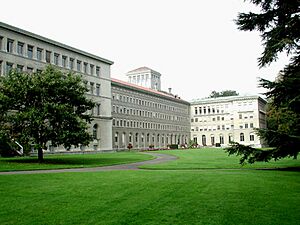
The Director-General is the leader of the WTO. They serve for four years. There are also four Deputy Directors-General. As of July 2025, Ngozi Okonjo-Iweala is the Director-General. Her Deputy Directors-General are:
- Angela Ellard (United States)
- Anabel González (Costa Rica)
- Ambassador Jean-Marie Paugam (France)
- Ambassador Xiangchen Zhang (China)
List of Directors-General
| Portrait | Name | Country | Term |
|---|---|---|---|
 |
Peter Sutherland | 1995 | |
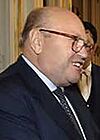 |
Renato Ruggiero | 1995–1999 | |
 |
Mike Moore | 1999–2002 | |
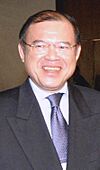 |
Supachai Panitchpakdi | 2002–2005 | |
 |
Pascal Lamy | 2005–2013 | |
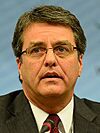 |
Roberto Azevêdo | 2013–2021 | |
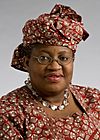 |
Ngozi Okonjo-Iweala | 2021– |
Choosing the Director-General in 2020
- Further information: Director-General of the World Trade Organization#2020 Director-General selection
In May 2020, the previous Director-General, Roberto Azevedo, announced he would step down. A process began to choose a new leader. On February 15, 2021, WTO members agreed to choose Ngozi Okonjo-Iweala of Nigeria.
Okonjo-Iweala made history as the first woman and the first African to become Director-General. Her term will end on August 31, 2025, but it can be renewed.
Budget and Funding
The WTO gets most of its money from its members. Each member contributes based on how much international trade they do.
| Rank | Country | CHF | Percentage |
|---|---|---|---|
| 1 | 22,808,985 | 11.667% | |
| 2 | 21,031,890 | 10.758% | |
| 3 | 14,058,405 | 7.191% | |
| 4 | 7,411,405 | 3.791% | |
| 5 | 7,387,945 | 3.779% | |
| 6 | 7,274,555 | 3.721% | |
| 7 | 5,778,980 | 2.956% | |
| 8 | 5,501,370 | 2.814% | |
| 9 | 5,350,835 | 2.737% | |
| 10 | 4,940,285 | 2.527% | |
| Others | 93,955,345 | 48.059% | |
| TOTAL | 195,500,000 | 100% | |
Impact of the WTO
Studies show that the WTO has helped increase trade around the world. Without the WTO, countries would likely face much higher taxes on their exports. The WTO's system for solving disagreements is one way it helps boost trade.
Research also shows that many recent trade agreements between countries mention the WTO. A lot of the language in these agreements is even copied directly from WTO agreements. This shows how important the WTO's rules are in global trade.
See also
 In Spanish: Organización Mundial del Comercio para niños
In Spanish: Organización Mundial del Comercio para niños
- Agreement on Trade Related Investment Measures
- Anti-globalization movement
- China and the World Trade Organization
- Criticism of the World Trade Organization
- Dispute settlement in the World Trade Organization
- Foreign Affiliate Trade Statistics
- Geographical Indications of Goods (Registration and Protection) Act, 1999
- Global administrative law
- Information Technology Agreement
- International Trade Centre
- Labour standards in the World Trade Organization
- Non-tariff barriers to trade
- North American Free Trade Agreement
- Swiss Formula
- Trade bloc
- UNIDROIT
- United Nations Commission on International Trade Law (UNCITRAL)
- Washington Consensus
- World Trade Organization Ministerial Conference of 1999 protest activity
- World Trade Report




